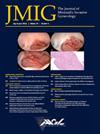大小重要吗?调查术前造影显示的子宫内膜异位症与 AAGL 子宫内膜异位症分期之间的关系
IF 3.5
2区 医学
Q1 OBSTETRICS & GYNECOLOGY
引用次数: 0
摘要
研究目的根据AAGL 2021年子宫内膜异位症分类,研究术前成像显示的子宫内膜异位症大小与腹腔镜检查结果显示的子宫内膜异位症分期和范围之间的关联。干预措施术前通过超声和/或磁共振成像评估子宫内膜异位症的大小和侧位.测量和主要结果69例患者符合纳入标准。从造影日期到手术日期的中位天数为 81 [40, 136] 天。患者的平均年龄为(34±7.3)岁。大多数患者自称是黑人(17.4%)或白人(75.4%),平均体重指数(BMI)为 27.8±6.8 kg/m2。最常报告的症状是痛经(95.7%),而月经失调(37.7%)和不孕(20.3%)较少见。在盆腔检查中,39.1%的患者有肌筋膜触痛,21.7%的患者有子宫骶骨结节或增厚,5.8%的患者子宫活动度降低。术前影像学检查显示,子宫内膜异位症的中位大小为:超声检查 49 [30, 62] mm(42 例),核磁共振成像检查 50 [23, 54] mm(27 例)。AAGL 子宫内膜异位症手术分期发现,没有患者属于 1 期疾病,79.7% 的患者属于 4 期疾病。与较小的子宫内膜异位症患者相比,子宫内膜异位症≥40 mm的患者通常手术复杂性更高,包括更常见的暗道闭塞(71.4% vs 48.1%)、直肠阴道隔疾病(35.7% vs 18.5%)和阑尾受累(38.1% vs 11.1%)。对于≥40 毫米的子宫内膜异位症,手术复杂程度更高。为子宫内膜异位症患者进行手术的妇科外科医生应做好治疗复杂子宫内膜异位症的准备。了解这种关系有助于临床医生考虑将患者转诊给妇科外科专家。本文章由计算机程序翻译,如有差异,请以英文原文为准。
Does Size Matter? Investigating the Association Between Endometrioma on Pre-Operative Imaging and AAGL Endometriosis Stage
Study Objective
To investigate the association between the size of endometriomas on pre-operative imaging and the stage and extent of endometriosis based on laparoscopic findings according to the AAGL 2021 Endometriosis Classification.
Design
Retrospective cohort study.
Setting
High-volume academic gynecologic surgical practice.
Patients or Participants
Sixty-nine patients with endometriomas on pre-operative imaging undergoing surgical management of endometriosis from June 2022 to April 2024.
Interventions
Preoperative assessment of endometrioma size and laterality on ultrasound and/or MRI.
Measurements and Main Results
Sixty-nine patients met the inclusion criteria. The median of days elapsed from imaging date to the date of surgery was 81 [40, 136] days. The mean age of patients was 34±7.3 years. The majority of patients self-reported as Black (17.4%) or White (75.4%) and the mean BMI was 27.8±6.8 kg/m2. The most commonly reported symptom was dysmenorrhea (95.7%) while dyschezia (37.7%) and infertility (20.3%) were less common. On pelvic exam, 39.1% had myofascial tenderness, 21.7% had uterosacral nodularity or thickening, and 5.8% had reduced uterine mobility.
Pre-operative imaging showed median endometrioma size of 49 [30, 62] mm on ultrasound (N=42) and 50 [23, 54] mm on MRI (N=27). Surgical AAGL endometriosis staging found that no patients had stage 1 disease while 79.7% had stage 4 disease. Patients who had endometriomas ≥ 40 mm often had higher surgical complexity as compared to those with smaller endometriomas, including more frequent cul-de-sac obliteration (71.4% vs 48.1%), rectovaginal septum disease (35.7% vs 18.5%), and appendiceal involvement (38.1% vs 11.1%).
Conclusion
In this sample, endometriomas on pre-operative imaging, regardless of size, were most frequently connected to stage III or IV endometriosis. For endometriomas ≥40 mm, a higher degree of surgical complexity was frequently encountered. Gynecologic surgeons operating on patients with endometriomas should be prepared to treat complex endometriosis. Understanding this relationship may aid clinicians considering referral to a gynecologic surgical specialists.
求助全文
通过发布文献求助,成功后即可免费获取论文全文。
去求助
来源期刊
CiteScore
5.00
自引率
7.30%
发文量
272
审稿时长
37 days
期刊介绍:
The Journal of Minimally Invasive Gynecology, formerly titled The Journal of the American Association of Gynecologic Laparoscopists, is an international clinical forum for the exchange and dissemination of ideas, findings and techniques relevant to gynecologic endoscopy and other minimally invasive procedures. The Journal, which presents research, clinical opinions and case reports from the brightest minds in gynecologic surgery, is an authoritative source informing practicing physicians of the latest, cutting-edge developments occurring in this emerging field.

 求助内容:
求助内容: 应助结果提醒方式:
应助结果提醒方式:


